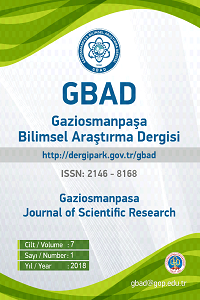İHA Görüntülerinde Hareket Tabanlı Nesne Sınıflandırması
Hareketli Nesne Tespiti, Nesne Takibi, Derin Öğrenme, Anomali Tespiti
Motion-Based Object Classification on UAV Images
Moving Object Detection, Object Tracking, Deep Learning, Anomaly Detection,
___
- Alkanat, T., Emre T., Sinan Ö., 2015. A Real-time, Automatic Target Detection and Tracking Method for Variable Number of Targets in Airborne Imagery, In VISAPP (2) 61-69.
- Bal M., Karakaya İ., Başeske E., 2017. Point based motion detection on UAV cameras, 2017 25th Signal Processing and Communications Applications Conference (SIU), 1–4. https://doi.org/10.1109/SIU.2017.7960468.
- Bulut F., 2017. A new clinical decision support system with instance based ensemble classifiers, Journal of the Faculty of Engineering and Architecture of Gazi University, 32 (1) 65-76.
- Carmona, E. J., Martínez-Cantos, J., & Mira, J., 2008. A new video segmentation method of moving objects based on blob-level knowledge, Pattern Recognition Letters, 29(3) 272-285.
- Chapel M-N, Bouwmans T., 2020. Moving objects detection with a moving camera: A comprehensive review., Computer Science Review, 38 (100310). https://doi.org/10.1016/j.cosrev.2020.100310.
- Chollet, F., 2018. Deep Learning with Python. Shelter Island, NY: Manning Publications.
- Da Rocha, D. A., Ferreira, F. M. F., Peixoto, Z. M. A., 2022. Diabetic retinopathy classification using VGG16 neural network, Research on Biomedical Engineering, 38 (2) 761-772.
- Deli̇başoğlu İ., 2022. Vehicle Detection from Aerial Images with Object and Motion Detection, Turkish Journal of Mathematics and Computer Science, 14 174–83. https://doi.org/10.47000/tjmcs.1002767.
- Fischer, P., Dosovitskiy, A., Ilg, E., Häusser, P., Hazırbaş, C., Golkov, V., Van der Smagt, P., Cremers, D., Brox, T., 2015. Flownet: Learning optical flow with convolutional networks.
- Girshick, R., 2015. Fast r-cnn, In Proceedings of the IEEE international conference on computer vision, 1440-1448.
- Jodoin, P. M., 2009. Mignotte, M., Optical-flow based on an edge-avoidance procedure, Computer Vision and Image Understanding, 113 (4) 511-531.
- Kriegel, H. P., Kroger, P., Schubert, E., Zimek, A., 2011. Interpreting and unifying outlier scores, In Proceedings of the 2011 SIAM International Conference on Data Mining, Society for Industrial and Applied Mathematics 13-24.
- Lin, C., 2021. Introduction to Motion Estimation with Optical Flow, (2019). Available at: https://nanonets.com/blog/optical-flow/. [Accessed 11 August 2021].
- Liu, W., Anguelov, D., Erhan, D., Szegedy, C., Reed, S., Fu, C. Y., Berg, A. C., 2016. Ssd: Single shot multibox detector, In European conference on computer vision, Springer, Cham 21-37.
- Logoglu, K. B., Lezki, H., Kerim Yucel, M., Ozturk, A., Kucukkomurler, A., Karagoz, B., Erdem, E., Erdem, A., 2017. Feature-based efficient moving object detection for low-altitude aerial platforms, In Proceedings of the IEEE International Conference on Computer Vision Workshops, 2119-2128.
- Pu, Y., Yang, H., Ma, X., Sun, X., 2019. Recognition of Voltage Sag Sources Based on Phase Space Reconstruction and Improved VGG Transfer Learning. Entropy, 21 (10) 999.
- Redmon, J., Divvala, S., Girshick, R., Farhadi, A., 2016. You only look once: Unified, real-time object detection, In Proceedings of the IEEE conference on computer vision and pattern recognition 779-788.
- Russakovsky, O., Deng, J., Su, H., Krause, J., Satheesh, S., Ma, S., Huang, Z., Karpathy, A., Khosla, A., Bernstein, M., Berg, A.C., 2015. Imagenet large scale visual recognition challenge, International journal of computer vision, 115 (3) 211-252.
- Teed, Z., Deng, J., 2020. Raft: Recurrent all-pairs field transforms for optical flow, In European conference on computer visioni, Springer, Cham, 402-419.
- Zhu J., Wang Z., Wang S., Chen S., 2020. Moving Object Detection Based on Background Compensation and Deep Learning, Symmetry, 12 (1965). https://doi.org/10.3390/sym12121965.
- ISSN: 2146-8168
- Yayın Aralığı: Yılda 3 Sayı
- Başlangıç: 2012
- Yayıncı: Tokat Gaziosmanpaşa Üniversitesi
LoRaWAN DLOS8 Ağ Geçidi için Siber Güvenlik Saldırısı ve Önlemleri
İsmail Hakkı ÖZDEMİR, Levent GÖKREM
Tümleyenli Esnek İkili Parçalı Fark ve Lambda İşlemlerine Farklı Bir Bakış
Genç Çiftçi Projesinin Sürdürülebilirliğinin İncelenmesi: Tokat İli Turhal İlçesi Örneği
Nuray KIZILASLAN, Kenan DAĞDELEN
Yeniden Silolamanın Mısır Silajlarının Fermantasyon Kalitesi ve Yem Değeri Üzerine Etkileri
İHA Görüntülerinde Hareket Tabanlı Nesne Sınıflandırması
Farklı Fosfor Dozları ve Mikoriza Uygulamasının Tokat Sarımsağında Verim ve Kalite Üzerine Etkileri
Biyomedikal Alanda Elmas Karbon (DLC) Kaplamaların Korozyon Direnci
Orhan Mete KILIÇ, Shıva SADIGHFARD
